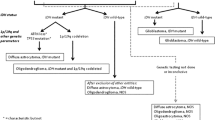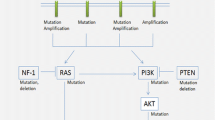Abstract
Glioblastomas are a heterogeneous group of tumors of neuroectodermal origin. Tumor cell cultures obtained from patients with glioblastomas differ in morphology and phenotype, as well as genetic characteristics. In the current work we used glioblastoma cell lines A172 and T98G (known since the 1970s) and the new glioblastoma lines R1 and T2 (obtained in 2010 from surgical material of patients). The purpose of this study was to evaluate the effect of the alkylating antitumor drug fotemustine (FM) after single and repeated exposure on the survival and proliferation of these glioblastoma cells, as well as the effect of FM on gene expression of growth factors, extracellular matrix proteins, mesenchymal cell markers, and transcription factor Zeb1. The effect of FM on A172 and R1 glioblastoma cells differs from its effect on T98G and T2 cells. LD50 was in an amount of 60 μg/mL for A172 cells and 250 μg/mL for T98G cells. Single exposure of A172 and R1 cell lines to 100 μg/mL of FM resulted in the death of all cells in culture. A172 and R1 cell exposure to sublethal doses of FM caused decreased activity of all studied genes. After incubation of T98G and T2 glioblastoma cells with FM in sublethal doses we identified two cell populations: proliferating cells and nonproliferating growth-arrested cells. Cell exposure to FM in doses over 300 μg/mL led to the predominance of growth-arrested cells in populations. These cells remained viable for 1.5 months. The effect of FM on T98G and T2 cell lines was accompanied by increased activity of all the studied genes. In conclusion, a population of growth-arrested, drug-resistant cells has been revealed in T98G and T2 cell cultures after exposure to FM. These cells exhibit high expression of genes encoding factors associated with the epithelial–mesenchymal transition. We discuss the possible impact of nonproliferating cells actively producing growth factors on the tumor microenvironment.
Similar content being viewed by others
Abbreviations
- fotemustine:
-
(FM)
- FCS:
-
fetal calf serum
- EMT:
-
epithelial mesenchymal transition
- dNTP:
-
deoxynucleotide triphosphate
- EGF:
-
epidermal growth factor
- FAP:
-
fibroblast activation protein
- FGF2(b):
-
basic fibroblast growth factor 2
- GAPDH:
-
glyceraldehyde-3-phosphate dehydrogenase
- HGF:
-
hepatocyte growth factor
- αSMA:
-
smooth-muscle actin α2
- TGFβ1:
-
transforming growth factor β1
- THBS1:
-
thrombospondin-1
- TNC:
-
tenascin C
- VEGF:
-
vascular endothelial growth factor.
References
Agnihotri, S., Gajadhar, A.S., Ternamian, C., Gorlia, T., Diefes, K.L., Mischel, P.S., Kelly, J., McGown, G., Thorncroft, M., Carlson, B.L., Sarkaria, J.N., Margison, G.P., Aldape, K., Hawkins, C., Hegi, M., and Guha, A., Alkylpurine-DNA-N-glycosylase confers resistance to temozolomide in xenograft models of glioblastoma multiforme and is associated with poor survival in patients, J. Clin. Invest., 2012, vol. 122, pp. 253–266.
Beauchesne, P., Fotemustine: a third-generation nitrosourea for the treatment of recurrent malignant gliomas, Cancers (Basel), 2012, vol. 4, pp. 77–87.
Brösicke, N. and Faissner, A., Role of tenascins in the ECM of gliomas, Cell Adh. Migr., 2015, vol. 9, pp. 131–140.
Chou, Y. and Yang, M., Epithelial-mesenchymal transition factors in solid tumor and hematological malignancy, J. Chin. Med. Assoc., 2015, vol. 78, pp. 438–445.
Erenpreisa, J. and Kalejs, M., Mitotic death: a mechanism of survival? A review, Cancer Cell Int., 2001, vol. 1, pp. 1–7.
Erenpreisa, J., Kalejs, M., and Cragg, M.S., Mitotic catastrophe and endomitosis in tumour cells: an evolutionary key to a molecular solution, Cell Biol. Int., 2005, vol. 29, pp. 1012–1018.
Gewirtz, D.A., Autophagy, senescence and tumor dormancy in cancer therapy, Autophagy, 2009, vol. 5, pp. 1232–1234.
Giard, D.J., Aaronson, S.A., Todaro, G.J., Arnstein, P., Kersey, J.H., Dosik, H., and Parks, W.P., In vitro cultivation of human tumors: establishment of cell lines derived from a series of solid tumors, J. Natl. Cancer Inst., 1973, vol. 51, pp. 1417–1423.
Guarino, M., Epithelial-mesenchymal transition and tumour invasion, Int. J. Biochem. Cell Biol., 2007, vol. 39, pp. 2153–2160.
Iwata, K., Yung, W.K., and Fields, W.S., In vitro effects of ACNU, BCNU, CDDP, and bleomycin on human glioma cells, Neurol. Med. Chir. (Tokio), 1988, vol. 28, pp. 965–969.
Jayachandran, A., Anaka, M., Prithviraj, P., Hudson, C., McKeown, S.J., Lo, P., Vella, L.J., Goding, C.R., Cebon, J., and Behren, A., Thrombospondin 1 promotes an aggressive phenotype through epithelial-to-mesenchymal transition in human melanoma, Oncotarget, 2014, vol. 5, pp. 5782–5794.
Kaur, E., Rajendra, J., Jadhav, Sh., Shridhar, E., Goda, J., Moiyadi, A., and Dutt, Sh., Radiation-induced homotypic cell fusions of innately resistant glioblastoma cell mediate their sustained survival and recurrence, Carcinogenesis, 2015, vol. 36, pp. 685–695.
Kiseleva, L.N., Kartashev, A.V., Vartanyan, N.L., Pinevich, A.A., and Samoilovich, M.P., Characteristics of A172 and T98G cell lines, Cell Tiss. Biol., 2016, vol. 10, no. 5, pp. 341–348.
Kiseleva, L.N., Kartashev, A.V., Vartanyan, N.L., Pinevich, A.A., Filatov, M.V., and Samoilovich, M.P., Characterization of new human glioblastoma cell lines, Cell Tiss. Biol., 2017 (in press).
Kubelt, C., Hattermann, K., Sebens, S., Mehdorn, H.M., and Held-Feindt, J., Epithelial-to-mesenchymal transition in paired human primary and recurrent glioblastomas, Int. J. Oncol., 2015, vol. 46, pp. 2515–2525.
Lagades, C., Vlashi, E., Della, Donna, L., Dekmezian, C., and Pajonk, F., Radiation-induced reprogramming of breast cancer cells, Stem Cells, 2012, vol. 30, pp. 833–844.
Lamouille, S., Xu, J., and Derynck, R., Molecular mechanisms of epithelial-mesenchymal transition, Nat. Rev. Mol. Cell Biol., 2014, vol. 15, pp. 178–196.
Livak, K.J., and Schmittgen, T.D., Analysis of relative gene expression data using real-time quantitative PCR and the 2–ΔΔCt method, Methods, 2001, vol. 25, pp. 402–408.
Mahabir, R., Tanino, M., Elmansuri, A., Wang, L., Kimura, T., Itoh, T., Ohba, Y., Nishihara, H., Shirato, H., Tsuda, M., and Tanaka, S., Sustained elevation of Snail promotes glial-mesenchymal transition after irradiation in malignant glioma, Neuro-Oncology, 2014, vol. 16, pp. 671–685.
Melendez, B., Garcia-Claver, A., Ruano, Y., Campos-Martin, Y., de Lope, A.R., Perez-Magan, E., Mur, P., Torres, S., Lorente, M., Velasco, G., and Mollejo, M., Copy number alterations in glioma cell lines, in Glioma. Exploring Its Biology and Practical Relevance, Rijeka: InTech., 2011, vol. 429–448.
Mirzayans, R., Andrais, B., Scott, A., Wang, Y.W., Kumar, P., and Murray, D., Multinucleated giant cancer cells produced in response to ionizing radiation retain viability and replicate their genome, Int. J. Mol. Sci., 2017, vol. 18, pp. 360–375.
Puck, T.T. and Marcus, P.I., A rapid method for viable cell titration and clonal production with HeLa cells in tissue culture: the use of X-irradiated cells to supply conditioning factors, Proc. Natl. Acad. Sci. U. S. A., 1955, vol. 41, pp. 432–437.
Puck, T.T. and Marcus, P.I., Action of X-rays on mammalian cells, J. Exp. Med., 1956, vol. 103, pp. 653–666.
Stein, G.H., T98G: an anchorage-independent human tumor cell line that exhibits stationary phase G1 arrest in vitro, J. Cell Physiol., 1979, vol. 99, pp. 43–54.
Yachi, K., Watanabe, T., Ohta, T., Fukushima, T., Yoshino, A., Ogino, A., Katayama, Y., and Nagase, H., Relevance of MSP assay for the detection of MGMT promoter hypermethylation in glioblastomas, Int. J. Oncol., 2008, vol. 33, pp. 469–475.
Zhang, S., Mercado-Uribe, I., Xing, Z., Sun, B., Kuang, J., and Liu, J., Generation of cancer stem-like cells through the formation of polyploidy giant cells, Oncogene, 2014, vol. 33, pp. 116–128.
Zhang, P., Sun, Y., and Ma, L., ZEB1: at the crossroads of epithelial-mesenchymal transition, metastasis and therapy resistance, Cell Cycle, 2015, vol. 14, pp. 481–487.
Author information
Authors and Affiliations
Corresponding author
Additional information
Original Russian Text © L.N. Kiseleva, A.V. Kartashev, N.L. Vartanyan, A.A. Pinevich, M.P. Samoilovich, 2018, published in Tsitologiya, 2018, Vol. 60, No. 1, pp. 21–29.
Rights and permissions
About this article
Cite this article
Kiseleva, L.N., Kartashev, A.V., Vartanyan, N.L. et al. The Effect of Fotemustine on Human Glioblastoma Cell Lines. Cell Tiss. Biol. 12, 93–101 (2018). https://doi.org/10.1134/S1990519X18020025
Received:
Published:
Issue Date:
DOI: https://doi.org/10.1134/S1990519X18020025




